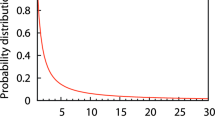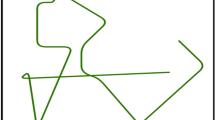Abstract
The objective of area exploration is to traverse the area effectively and random walk methods are the most commonly used searching strategy for swarm robots. Existing research mainly compares the effectiveness of various random walk methods through experimental verification, which has relatively large limitations. In order to make the application of the random walk methods more convenient, this paper quantitatively analyzes the searching efficiency (SE) of random walk methods. Firstly, the formula of the mean square displacement (MSD) of the robot position is given, and it is shown that the mean and the variance of the random step length are the factors that affect the SE. In addition, in order to produce the suitable step length, a truncated random walk method is constructed to make the generated step lengths follow a given distribution and the step lengths are within a specified range, thereby improving the SE. Thirdly, the correlations between the step length threshold (SLT), the area of the region, and the number of robots are provided based on MSD and truncated random walk method. When the area of region and the number of robots are fixed, there exists a SLT. When the expectation of the step length is greater than SLT, the swarm robots can achieve the highest SE. The area exploration task of swarm robots are carried out in simulation experiments and the coverage ratio is used to evaluate the SE of each random walk method. The experimental results show that when the area and the number of robots are given, there exist an optimal step length, which can enable the robots to achieve the optimal search.




Similar content being viewed by others
References
Rone W, Ben-Tzvi P (2013) Mapping, localization and motion planning in mobile multi-robotic systems. Robotica 31(1):1–23
Savkin AV, Li H (2018) A safe area search and map building algorithm for a wheeled mobile robot in complex unknown cluttered environments. Robotica 36(1):96–118
Kegeleirs M, Ramos DG, Birattari M (2019) Random walk exploration for swarm mapping. Ann Conf Towards Auton Robot Syst:211–222
Curtis S, Rilee M, Clark P (2003) Use of swarm intelligence in spacecraft constellations for the resource exploration of the asteroid belt. In: Proceedings of the Third International Workshop on Satellite Constellations and Formation Flying, pp 24–26
St-Onge D, Kaufmann M, Panerati J et al (2019) Planetary exploration with robot teams: Implementing higher autonomy with swarm intelligence. IEEE Robot Autom Mag 27(2):159–168
Waharte S, Trigoni N, Julier SJ (2009) Coordinated search with a swarm of uavs, IEEE Annual Communications Society Conference on Sensor, Mesh and Ad Hoc Communications and Networks Workshops, pp 1–3
Pitonakova L, Crowder R, Bullock S (2016) Information flow principles for plasticity in foraging robot swarms. Swarm Intell 10(1):33–63
Wei Y, Yasuda T, Ohkura K (2017) Autonomous task allocation for swarm robotic systems using behavioral decomposition, Intelligent and Evolutionary Systems. Springer International Publishing, Cham, pp 469–481
Carrillo M, Gallardo I, Ser JD et al (2018) A bio-inspired approach for collaborative exploration with mobile battery recharging in swarm robotics// Bioinspired Optimization Methods and Their Applications. Springer, Cham
Sharma S, Shukla A, Tiwari R (2016) Multi robot area exploration using nature inspired algorithm. Biol Inspired Cogn Archit 18:80–94
Baranzadeh A, Savkin AV (2017) A distributed control algorithm for area search by a multi-robot team. Robotica 35:1452–1472
Osswald S, Bennewitz M, Burgard W et al (2016) Speeding-up robot exploration by exploiting background information. IEEE Robot Autom Lett 1(2):716–723
Albina K, Suk GL (2019) Hybrid stochastic exploration using grey wolf optimizer and coordinated multi-robot exploration algorithms. IEEE Access 7:14246–14255
Sims DW, Reynolds AM, Humphries NE et al (2014) Hierarchical random walks in trace fossils and the origin of optimal search behaviour. Proc Natl Acad Sci 111(30):11073–11078
Ducatelle F, Caro GD, Frster A et al (2014) Cooperative navigation in robotic swarms. Swarm Intell 8(1):1–33
Viswanathan GM, Raposo EP, Da Luz MGE (2008) Lévy flights and superdiffusion in the context of biological encounters and random searches. Phys Life Rev 5(3):133–150
imidov DC, Oriolo G, Trianni V (2016) Random walks in swarm robotics: an experiment with kilobots, International Conference on Swarm Intelligence. Springer, pp 185–196
Francesca G, Brambilla M, Brutschy A et al (2014) Automode: a novel approach to the automatic design of control software for robot swarms. Swarm Intell 8(2):89–112
Dorigo M, Floreano D, Gambardella LM et al (2013) Swarmanoid: a novel concept for the study of heterogeneous robotic swarms. IEEE Robot Autom Mag 20(4):60–71
Li S, Batra R, Brown D (2019) Particle robotics based on statistical mechanics of loosely coupled components. Nature 567(7748):361
RobertBrown FRS, Hon MRSE, Acad RI (2015) A brief account of microscopical observations made in the months of June, July and August 1827, on the particles contained in the pollen of plants; and on the general existence of active molecules in organic and inorganic bodies. Phil Mag 4(21):161–173
Pang B, Song Y, Zhang C (2019) A swarm robotic exploration strategy based on an improved random walk method. Journal of Robotics
Sims DW, Humphries NE, Bradford RW et al (2012) Lévy flight and Brownian search patterns of a free-ranging predator reflect different prey field characteristics. J Anim Ecol 81(2):432–442
Itami T (2014) Controlling Brownian motion applied to macroscopic group robots without mutual communication. In: Proceedings of the 2014 19th International Conference on Methods and Models in Automation and Robotics (MMAR), pp 903–908
Munishkin AA, Milutinovi D, Casbeer DW Safe navigation with the collision avoidance of a brownian motion obstacle. In: Proceedings of the ASME 2017 Dynamic Systems and Control Conference. Am Soc Mech Eng
Viswanathan GM, Afanasyev V, Buldyrev SV (2001) Lévy fights search patterns of biological organisms. Physica A: Stat Mech Appl 295(1):85–88
Wagner IA, Lindenbaum M, Bruckstein AM (1998) Robotic exploration, Brownian motion and electrical resistance. Randomization and Approximation Techniques in Computer Science, pp 116–130
Martinez F, Jacinto E, Acero D (2012) Brownian motion as exploration strategy for autonomous swarm robots. 2012 IEEE International Conference on Robotics and Biomimetics (ROBIO), pp 2375–2380
Fujisawa R, Dobata S (2013) Lévy walk enhances efficiency of group foraging in pheromone-communicating swarm robots. In: 2013 IEEE/SICE International Symposium On System Integration (SII). IEEE, pp 808–813
Schroeder A, Ramakrishnan S, Kumar M et al (2017) Efficient spatial coverage by a robot swarm based on an ant foraging model and the Lvy distribution. Swarm Intell 11(1):39–69
Fricke GM, Hecker JP, Cannon JL et al (2016) Immune-inspired search strategies for robot swarms. Robotica 34(08):1791–1810
Deshpande A, Kumar M, Ramakrishnan S (2017) Robot swarm for efficient area coverage inspired by ant foraging: The case of adaptive switching between Brownian motion and Lvy flight. In: ASME 2017 Dynamic Systems and Control Conference, pp V002T14A009
Codling EA, Plank MJ, Benhamou S (2008) Random walk models in biology. J R Soc Interface 5(25):813–834
Mardia KV, Jupp PE (1999) Directional statistics. Wiley, Chichester
Kareiva R, Shigesada N (1983) Analyzing insect movement as a correlated random walk. Oecologia 56(2):234–238
Viswanathan GM, Buldyrev SV, Havlin S et al (1999) Optimizing the success of random searches. Nature 401(6756):911–914
Sims DW, Southall EJ, Humphries NE et al (2008) Scaling laws of marine predator search behaviour. Nature 451(7182):1098–1103
Edwards AM, Phillips RA, Watkins NW et al (2007) Revisiting lévy flight search patterns of wandering albatrosses, bumblebees and deer. Nature 449(7165):10441049
Reynolds AM, Frye MA (2007) Free-flight odor tracking in Drosophila is consistent with an optimal intermittent scale-free search. PloS one 2(4):e354
Acknowledgments
This work is supported by the National Natural Science Foundation of China under Grants (61973184, 61673245, 61803227), Independent Innovation Foundation of Shandong University under Grant 2018ZQXM005, The Development Plan of Youth Innovation Team in Colleges and Universities of Shandong Province under Grant 2019KJN011, and National Social Science Foundation of China under Grant 20ASH009.
Author information
Authors and Affiliations
Corresponding author
Additional information
Publisher’s note
Springer Nature remains neutral with regard to jurisdictional claims in published maps and institutional affiliations.
Rights and permissions
About this article
Cite this article
Pang, B., Song, Y., Zhang, C. et al. Effect of random walk methods on searching efficiency in swarm robots for area exploration. Appl Intell 51, 5189–5199 (2021). https://doi.org/10.1007/s10489-020-02060-0
Accepted:
Published:
Issue Date:
DOI: https://doi.org/10.1007/s10489-020-02060-0




